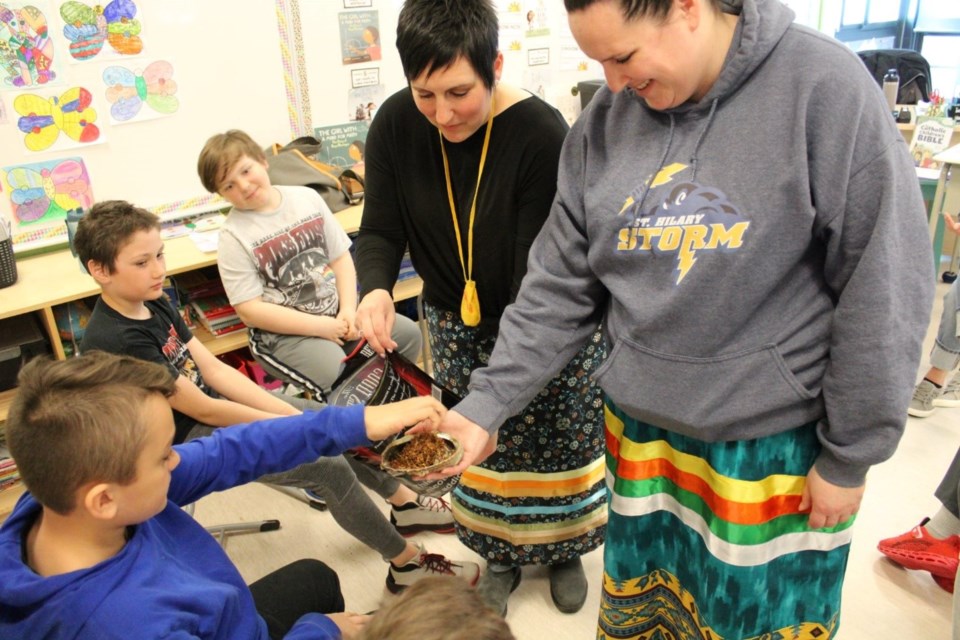Smudging has been a huge part of First Nation’s tradition and culture and continues to be a daily activity passed down from generation to generation. Elders and Knowledge Keepers pass down this tradition to their youth.
Smudging for Indigenous peoples allows them to take time during the day to stop what they are doing, to slow down, and become mindful and centred. It facilitates an opportunity to remember, connect, and be grounded in the activity, or the task at hand.
It is not uncommon for smudging to be an introductory activity before meetings, conferences, and celebrations. This is because the tradition behind smudging is that it is a ceremony engaged in by the individual or the group as a means of purifying or cleansing the soul of any negative thoughts.
Smudging is also a very common tradition to many Anishinaabe people and typically involves burning one or more medicines gathered in nature.
The Seven Generations Education Institute offers key words and phrases in Anishinaabemowin for their students to learn and use when smudging.
- Mashkodewashk – Sage
- Aseema – Tobacco
- Nookwezhigewin – Smudging
- Nookwezige – He/she is smudging medicinally
These are the most commonly used medicines: sage (mashkodewashk), sweetgrass (wiingashk) and cedar (giizhik). When used, each medicine will produce a different amount of smoke.
According to SGEI, “When we smudge, we can connect and become grounded. Smudging can help us feel calm and safe and allows us to let go of negative feelings and thoughts.”
The word smudging originates from the English word “smudge” and means “a blurry spot or streak”. Smudging is a common tradition to many Anishinaabe people and typically involves burning one or more medicines gathered in nature.
The Purpose of Smudging
According to the SGEI smudging connect people to the Creator so it is a very spiritual activity. The belief is that it is a spiritual act that protects and allows one to receive blessing from the Creator. It is believed to also improve spiritual health.
The smoke produced during the smudging ceremony is produces by burning medicines that purify the body, and soul and as a result it clarifies the mind. It gets rid of negative energy, and can be done anytime during the day or night.
Preparing the bowl for smudging: Steps:
Smudging has been passed down from generation to generation, and there are many ways to perform a smudge.
A common way to smudge throughout the Treaty #3 territory is to place a small pinch of what is known as asemaa (tobacco) in an abalone shell or copper vessel.
Then one takes a tightly balled-up bundle of dried sage (mashkodewashk), light it from the bottom with a match, and place it on top of the tobacco. A small amount of smoke is all that’s necessary. The smoke from the smudge can be pulled toward oneself with your hands or pushed by another person using a feather or an eagle fan.
The person who lights the smudge should smudge themselves first before bringing the bowl around to others.
Smudging our bodies:
The smoke from smudging is seen as being similar to the water that we cleanse our bodies with, but instead, it cleanses our spirits. It is said that when we smudge, we cover a few key areas: the mind (top of the head), ears, eyes, mouth, heart, back, hair, and whole being (push the smoke down the body towards the floor) and the feet. First, one needs to cleanse their hands with the smoke as if we were washing our hands. Then draw the smoke over all of those different areas listed.
Each area that we smudge carries a different purpose. Some areas include the following:
- Mind: to have good thoughts
- Eyes: to see the good in others
- Ears: to listen and hear good sounds
- Mouth: to speak well of others
- Heart: to purify our hearts
- Back: to have others watch our back
- Hair: to take care of our lifeline
- Whole being: to portray only the good part of ourselves through our actions
- Feet: to walk a good life
Once the smudge is completed, the smudge ball can burn out naturally. Some choose to bury the ashes or wash them away with water.
Smudging has also been incorporated into school curriculum across the Northshore region. St. Hilary Catholic School educators Ashley Muir and Lisa Copp set one of their goal as one that would foster students and educators towards reconciliation and cultural appreciation. As a result, they both organized and facilitated a smudging celebration at St. Hillary Catholic School, on June 6, 2022.
Classroom educators, and students were able to learn about the spiritual significance of smudging and its importance to Indigenous Cultural practices. By participating in their own smudging activity, they not only could learn and get a sense for what smudging represents to Indigenous people but also they themselves could benefit from it.



